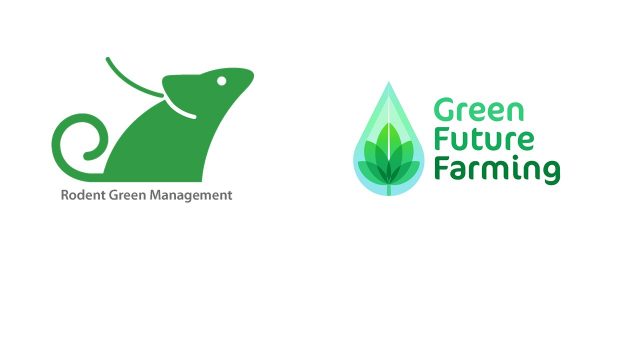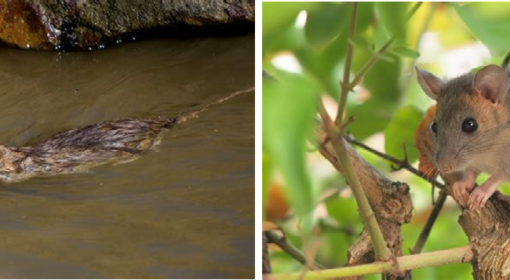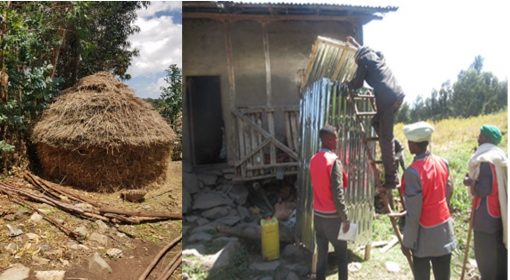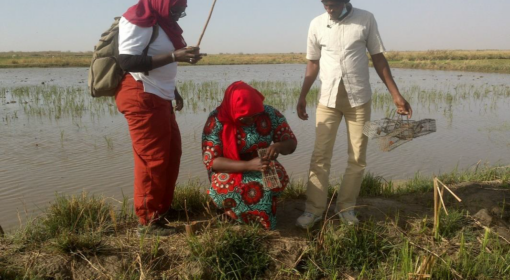By Meheretu Yonas – Rodent Green Management
Rodent pests and rodenticide use in Ethiopia
Ethiopia’s economy heavily depends on agriculture, it contributes ~ 37% to the GNP, ~ 80% of the export revenues, and employs about ~ 73% of the population. However, the sector suffers from several problems including pest-related constraints across the value chain. Anecdotal estimates indicate that pre- and post-harvest crop damages and yield losses to pests in Ethiopia account for between 30 and 40% annually, though empirical data is generally lacking. In Ethiopia, 100+ species of rodents have been recorded, approximately a dozen are significant agricultural pests. The main pest species (both field and storage) belong to the following five genera: Arvicanthis, Gerbilliscus, Mastomys, Stenocephalemys, Tachyoryctes, and Rattus.
Apart from being serious concerns to agriculture, rodents have a major public and veterinary importance, because they act as reservoirs and vectors of several infectious pathogens. It has been reported that rodents can transmit over 60 different pathogens to humans and animals, including noxious viral, bacterial, and protozoal diseases. Those most exposed to these rodent impacts are usually poor community who leave in poor sanitary conditions and lack the knowledge and the means to manage them.
There is hence a huge need to manage the rodent problem in a safe and responsible way and to build up a sector that deals with this societal challenge effectively. Current practice is far from that with persistent toxins used often without proper guidance.
Together with trapping, rodenticide (mainly zinc phosphide, Fig. 1) application is the most practiced rodent management method in crop fields in Ethiopia. Other rodenticides in use are Brodifacoum, Bromadiolone, and Flocoumafen as observed from the local markets. The rodenticide import, distribution and regulation systems in Ethiopia are unclear (unknown) since data is unavailable (e.g., Mengistie et al. 2016). It is difficult to find information as to which rodenticides are being imported, their expenditures, method of distribution, monitoring and surveillance systems. For instance, according to United Nations COMTRADE database, Ethiopia imported US$ 6.68 million and US$ 8.71 million worth of insecticides, rodenticides, fungicides, herbicides, and plant-growth regulators from Germany and Belgium in 2017, respectively. However, it is not clear how much is the share of the rodenticides is this expenditure. The involvement of the private actor too is unclear and only visible from local retail markets. However, the inefficiencies in the supply chain as a whole suggests that the role of the private sector too is weak. These deficiencies have partly contributed to unclear supply chain actors, inefficient and unsafe use. It is likely that these factors have also contributed to public and environmental safety and risks. Under severe infestation conditions, rodenticides are used in storage areas and houses in Ethiopia risking the health of humans and domestic animals. For instance, a retrospective cross-sectional study from Debre Tabor general hospital, a district hospital in northern Ethiopia, revealed that out of the 102 patients admitted to the hospital presenting acute poisoning between Sep. 2013 to Aug. 2016, rodenticide poisoning accounted for 56.9% (n = 58) of the cases with a mortality rate of 18.6% (19 cases) (Endayehu and Shenkutie, 2019). In a study in northern Ethiopia, ~ 93% of surveyed cereal farmers reported the use of zinc phosphide rodenticide in rainfed crop fields to manage rodent pests (Meheretu et al. 2010). About 87% of the farmers decided to buy (apply) the rodenticide after noticing intense rodent activities in the fields, suggesting that rodent management is symptomatic, not integrated into part of the routine pest management activities.
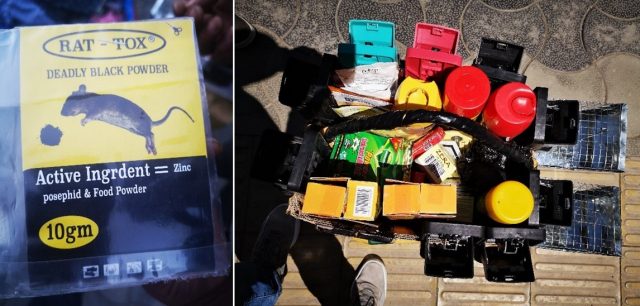
The supply of rodenticides is limited in Ethiopia; hence farmers buy it from local retail markets (Fig. 2) or receive it free of charge (or with a reduced price) from a district agricultural office. Unfortunate, the rodenticides are often sold (packed) in a very small quantity and without user instruction, including expiry dates. Of note, apart from safety concerns, poor awareness of rodenticide application is likely to result in weak efficacy of action and treatment failure, leading to apathy and widespread acceptance of rodent pests in fields and storage areas. For instance, in several regions in Ethiopia, people fear calling rats by the name ‘rats’, rather they tend to call it ‘bride’ and ‘queen’. This is based on the belief that if one calls a rat by the name ‘rat’, the rat will increase in number in the fields or storage areas and avenge by attacking crops out of lack of respect. It is a sign of the severity of the problem and the attitude of farmers who do not know how to deal with it.
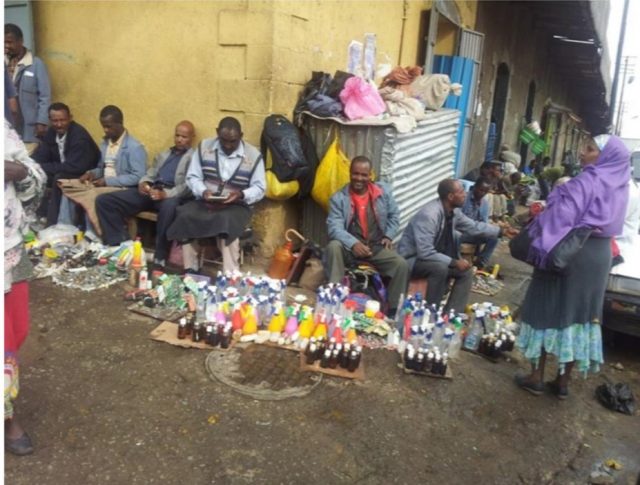
Recently, a team of researchers from MetaMeta Research B.V., Mekelle University and Amhara Bureau of Agriculture have developed a prototype bio-rodenticide (rodenticide originated from a blend of plant materials) in Ethiopia (Fig. 3) through laboratory and field testing and it has been proven effective in reducing rodent populations significantly. Efforts are underway to ensure wider use of the bio-rodenticide in Ethiopia and other African countries.

There is also a rodenticide called ‘Zera Rat and Cockroach Destroyer’ that entered the Ethiopian retail market and is being sold in open markets (Fig. 4). It is manufactured by Zera Corporates (https://zera-corporate-office.business.site/) which claims to have been ‘manufactured by Ethiopian researchers in a way that does not pose a health risk to the community’. However, there is no report on vital information on the product, including those related to its chemistry, efficacy, and public and environmental risks. Neither the company nor the national pesticide regulators have disclosed such information regardless of its wide-open sales, including on the streets of big cities like Addis Ababa with street advertising taking using loudspeakers (Fig. 4).
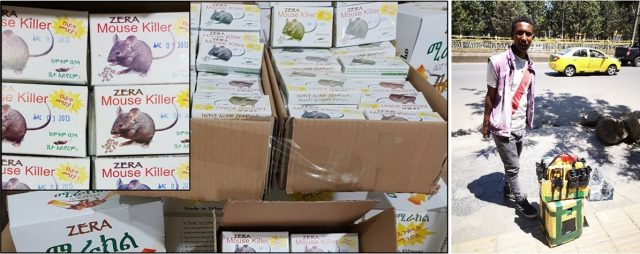
To address the impact of rodents on agriculture and health in Ethiopia and reduce the heavy reliance on rodenticides, a direction towards Ecologically-Based Rodent Management (EBRM) strategy is recommended. EBRM promotes the need for developing environmentally friendly management methods by combining scientific knowledge on the biology, ecology, and behaviour of the rodent pests locally occurring along with socio-economic dimensions (Singleton et al. 2004). EBRM also promotes a thorough understanding of the traditional pest management practices and combining them with scientific knowledge. EBRM has been introduced to farmers in Asia, Australia, and eastern Africa where several signs of progress have been made.
Alternative management direction
Despite the short-term benefits, the long-term consequences of reliance on rodenticide should be a concern, particularly in a situation where knowledge of proper utilization of rodenticides (e.g., storage, dosage and time of application) is poor. Farmers and extension workers (district officials supplying the poison to the farmers) should be made aware of the potential danger the poison might result on non-target animals and the environment. Research is needed to evaluate the cost-effectiveness, efficacies and environmental harm of rodenticides sold in local retail and distributed by agricultural offices. The traditional rodent management practices of the farmers should be better understood and combined with scientific knowledge.
Equality important is filling the gaps in clarity in rodenticide import, distribution and regulation systems in Ethiopia and availability of information including in monitoring and surveillance systems. The involvement of the private actor should be encouraged with clear role and responsibility to tackle the problems of inefficiencies in the supply chain.
References
Endayehu, Y., Shenkutie, E. (2019). Magnitude of Acute Poisoning and Associated Factors in Debretabor General Hospital, Ethiopia. Journal of Clinical Toxicology, 9, 429.
Meheretu, Y., Welegerima, K., Deckers, S., Raes, D., Makundi, R., Leirs, H. (2010). Farmers’ perspectives of rodent damage and management from the highlands of Tigray, Northern Ethiopia. Crop Protection, 29, 532–539.
Mengistie, B.T., Mol, A.P.J. and Oosterveer, P. (2016). Private Environmental Governance in the Ethiopian Pesticide Supply Chain: Importation, Distribution and Use, NJAS – Wageningen Journal of Life Sciences, 76, 65-73.
Singleton, G.R., Brown, P.R., Jacob, J. (2004). Ecologically-based rodent management: its effectiveness in cropping systems in South-East Asia. Njas-Wageningen Journal of Life Sciences, 52, 163–171.
